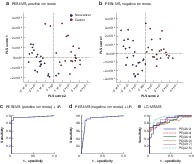- Record: found
- Abstract: found
- Article: found
Breast cancer diagnosis based on lipid profiling by probe electrospray ionization mass spectrometry
brief-report
T. Iwano
1 ,
K. Yoshimura
1 ,
S. Inoue
2 ,
T. Odate
3 ,
K. Ogata
4 ,
S. Funatsu
4 ,
H. Tanihata
4 ,
T. Kondo
3 ,
D. Ichikawa
2 ,
S. Takeda
1
,
04 April 2020
Read this article at
There is no author summary for this article yet. Authors can add summaries to their articles on ScienceOpen to make them more accessible to a non-specialist audience.
Abstract
Probe electrospray ionization mass spectrometry (PESI‐MS) is an ambient ionization‐based mass spectrometry method that surpasses the original electrospray ionization technique in features such as the rapidity of analysis, simplicity of the equipment and procedure, and lower cost. This study found that the PESI‐MS system with machine learning has the potential to establish a lipid‐based diagnosis of breast cancer with higher accuracy, using a simpler approach.
Rapid mass spectrometry for breast cancer
Related collections
Most cited references17
- Record: found
- Abstract: found
- Article: found
Novel theranostic opportunities offered by characterization of altered membrane lipid metabolism in breast cancer progression.
Mika Hilvo, Carsten Denkert, Laura Lehtinen … (2011)

- Record: found
- Abstract: found
- Article: found
Rapid evaporative ionisation mass spectrometry of electrosurgical vapours for the identification of breast pathology: towards an intelligent knife for breast cancer surgery
Edward R. St John, Júlia Balog, James McKenzie … (2017)
